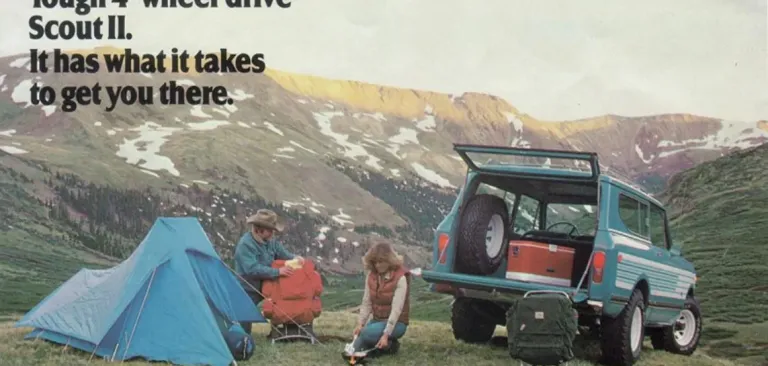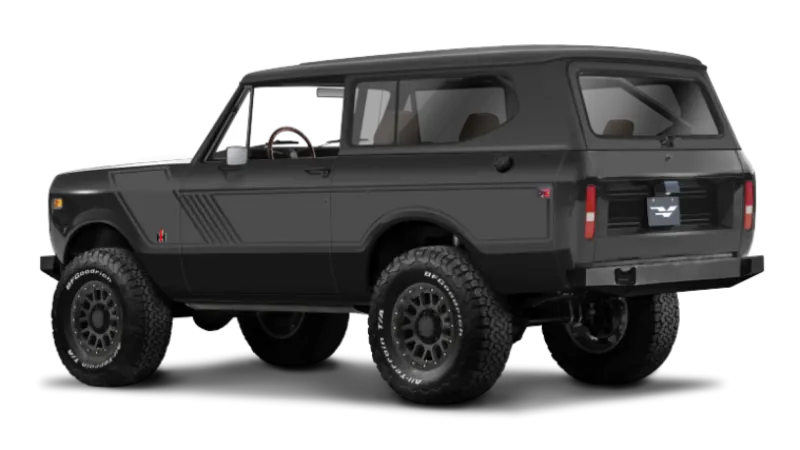SUVs have become so ubiquitous in the American way of life that we hardly stop to realize just how much things have changed over the last forty years.
What were once rugged, go-anywhere, do-anything machines that offered off-road capabilities, have turned into car-based pseudo-wagons that have all but replaced the humble sedan. It’s not hard to see why, especially for those of us that have a family or a dog. Plenty of room, decent fuel economy, and strong safety scores mean the SUV will continue to be the ride of choice for millions and millions of people.
If we roll the clock back a few decades, back to a time when disco was king and an entire generation of Americans was growing up, things were very different. SUVs were far from the car-based family machines of today. Instead, they were ruggedly designed to take their owners out to high-elevation campsites, remote beaches, or wherever the spirit of adventure drew their soul.
For these types of folks, a humble agricultural magnate known for making commercial trucks and tractors offered just the type of sport utility vehicle that 4x4 enthusiasts were looking for. That SUV was the International Harvester Scout, and it completely changed the way people hit the road to adventure.
Before the Bronco, before the Jeep Wagoneer, there was the Scout, and later on down the road, the Scout II.
For 2024, Velocity is bringing back the Scout II in a completely reimagined way, but before we focus on the future, let’s take a look at the past.
Mission 66 Creates Outdoors Enthusiasts
 Grand Teton National Park - Credit
Grand Teton National Park - CreditTo understand why the Scout, Bronco, and Jeep CJ became so popular in the 1960s and 1970s, we need to look back at the post-war years after World War II.
In the post-war rebuilding years, America’s road network grew exponentially thanks to the introduction of the interstate system in 1956. Suddenly, an American family could hop in their family vehicle (typically a wagon in those days) and explore the country affordably. Since gasoline was around 20 cents a gallon, traveling on summer vacation was relatively affordable for working families for the first time in history.
Along with the creation of the interstate highway system, National Park Service Director Conrad L. Wirth championed an initiative known as Mission 66 to help boost attendance and preserve historic sites across America’s National Parks. To be frank, visitation to the National Park System increased from 17 million in 1940 to 56 million in 1956, and the parks could not handle the increase. Mission 66 changed this by creating dozens of visitor centers, campgrounds, and general enhancements to National Park Service parks.
Attendance again grew across America’s National Parks, and more people than ever began to truly enjoy outdoor recreation which included camping, and you guessed it, off-roading.
The Birth Of The Off-Road SUV
 International Scout 800 - Credit
International Scout 800 - CreditAs happy as most of the young men and women were to be home, G.I.s returning from both the European and Pacific theatres found themselves missing one thing in particular: the Willys Jeep.
Thanks to some savvy thinking, Jeep began to offer a civilian version of the Jeep in 1944 to ring that nostalgic bell for veterans. For all intents and purposes, the CJ was exclusively a top-down recreation machine that was about as bare bones as you can get. If you wanted to take a few people or your stuff along for the ride, you were out of luck since the CJ was only a thinly veiled version of the military runabout.
Interstate expansion and the increasing interest in exploring our National Parks meant that more and more people (especially baby boomers) were looking for vehicles that could head off the beaten path but still be daily drivers, and the top brass at International Harvester saw an opportunity to introduce a competitor to the CJ that would offer more utility, style, and capability. In a remarkable feat of teamwork, the initial Scout 80 design and production came together in only two years. Since IH was much smaller than the Big Three, this feat is even more impressive.
Initially offered as a short-bed pickup truck, or with a hardtop (known as the Traveltop) the Scout 80 was an absolute smash hit. At $2,128.84, the Scout 80 was incredibly affordable for the average buyer and it coincided with America’s desire to get out into the great outdoors and experience the splendor of our country. As the Scout 80 line aged, it gradually expanded to include options like rear seats (yes, the original didn’t have rear standard rear seats), optional bucket seats, two-way radio, and other nice-to-have features that made the trip out to adventure a pleasure.
By the time the Bronco hit the streets in 1966, the recreational SUV craze was well underway and the Scout 80 was right at the center of it all.
Scout II: Evolution, Not Revolution
 1978 International Scout II Catalog Cover - Credit
1978 International Scout II Catalog Cover - CreditAmerican manufacturers quickly realized that demand for rugged, recreational SUVs was on a steep upward trend.
Along with the Bronco, the Scout was also facing stiff competition from the Chevy Blazer, Dodge Ramcharger, and even the Toyota Land Cruiser. To help the Scout stay competitive, IH took an evolutionary approach to the Scout and increased its size a bit, along with adding more engine options and additional comfort features to make it more of a daily driver than a weekend toy. Styling was also enhanced with the introduction of the iconic grill and round headlights.
Just like Scout I, the Scout II offered a roadster model with a truck bed, a steel “Traveltop” and a soft top. Early on, IH dubbed the Traveltop” as the “Scout Wagon” to capture some of the popularity of station wagons, but in a much smaller package.
 1972 Scout II - Credit
1972 Scout II - CreditThe Wheelbase was increased to 100 inches, which meant the Scout II wagons had more interior room for the standard second-row bench seat, which also folded to increase overall cargo capacity. Color-keyed interiors were also standard on hardtop Scout II models with the “Deluxe Package”, along with options for dome lights, luggage racks, and even a cigarette lighter. Bumping up to the Custom Trim package brought additional features like an insulated roof, window tinting, and more. From rolling to the campsite to heading to a garage sale, the Scout II could really do it all.
Since vehicles in the 1970s fell victim to the oil embargo and emissions restrictions of the newly formed EPA, the Scout rolled with engine options that were potent as they could be for the era. Standard Scout II models rolled out with the 111 horsepower Comanche four-cylinder, but options included an inline-six and a 345 cubic inch V8 with 197 horsepower. Properly equipped, the Scout II could tow up to 3000 pounds, which was quite a bit for the era. Transmission options included everything from a 3-speed manual to a 4-speed automatic on V8 models.
 1972 International Scout II - Credit
1972 International Scout II - CreditAs the Scout II aged, it was marketed more and more towards outdoors and 4x4 enthusiasts instead of family wagon duty. The vast majority of Scout II models came with a fully selectable 4x4 system that offered serious traction in the roughest terrain, while a four-leaf spring suspension design offered the type of durability that drivers demanded. 4x4 models also came with locking hubs, with optional automatic locking hubs available. Late 1970s Rallye package-equipped models also came with specific vinyl trim, larger shocks, beefier tires and wheels, and a standard tilt steering column.
Late in the production run, the Scout II had a healthy options sheet that included things like air conditioning, AM/FM radio, and even cruise control. The interior was basic, but still retained a classic, nostalgic feel and was dressed up with era-specific colors.
 1978 IH Scout II Interior Colors - Credit
1978 IH Scout II Interior Colors - CreditIn 1979, the UAW proposed and executed a strike against International Harvester. Rather than adhere to their demands, IH dug its heels in for a staggering 172 days. This maneuver cost the company $257.2 million in the second quarter of 1979, and a total of $479.4 million overall. Sales slid nearly 50% due to a lack of product and bad optics, and by the time the dust had settled, there was no money to redesign the Scout II and it was abruptly killed off.
Management reached out for concessions on demands, but the request was denied due to healthy bonuses paid out to everyone except for the hourly workers at International. Thanks to billions in debt and terrible management, International Harvester sold off its assets in 1985 and reformed as Navistar in 1986.
Just like that, one of the coolest SUVs to ever roam the roads was gone, along with an iconic American brand.
Own A True Modern Classic Starting In 2024
Velocity allows IH and 4x4 enthusiasts to relive the glory days when the Scout II was the SUV of choice for enthusiasts who were looking to live life’s biggest adventures.
Our guaranteed build time and state-of-the-art production line ensure that every IH Scout II that rolls out of our facility achieves the highest levels of fit and finish possible, while still allowing our clients to meticulously design their build. These are not just restorations, but modern interpretations of classic vehicles that are built to be driven every single day and passed down to the next generation. Everything we build comes from the heart and soul of every Velocity employee and we’re proud to keep the iconic design of American legends like the Scout II rolling into a new generation.
Velocity is now accepting refundable deposits of $2500 for Scout II deliveries starting in 2024. Act fast, because demand is high for this all-American classic.
Learn more about the Velocity Signature International Scout II here.
To learn more about our Signature Scout II or to reserve one, please contact us today.


